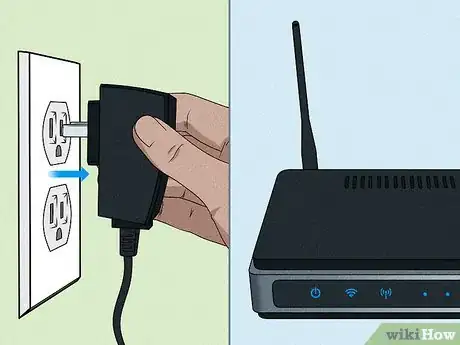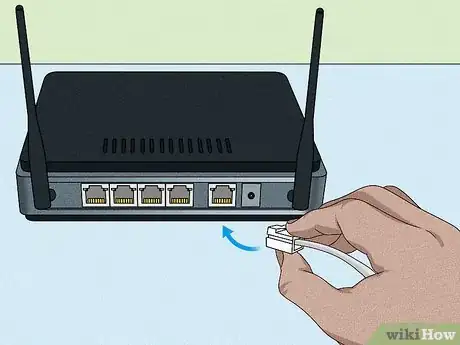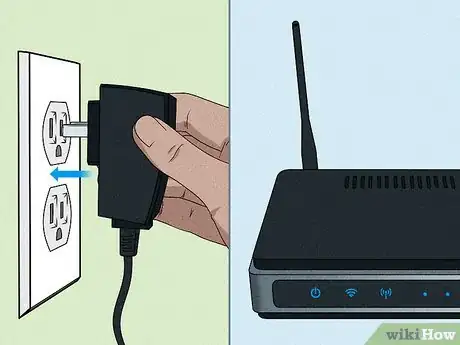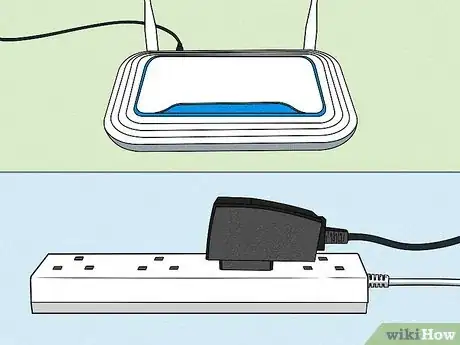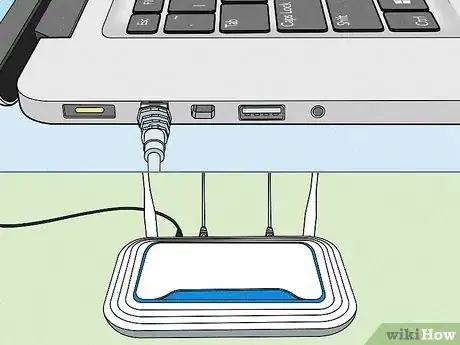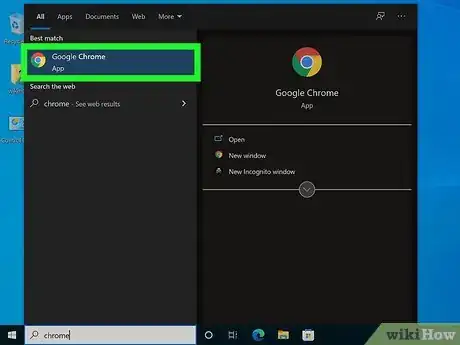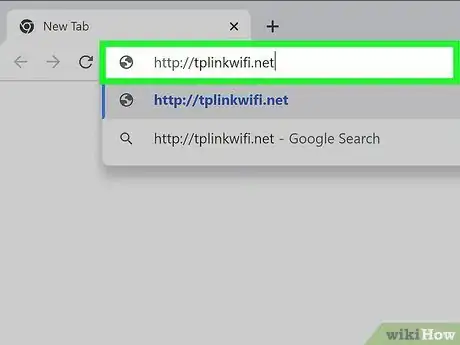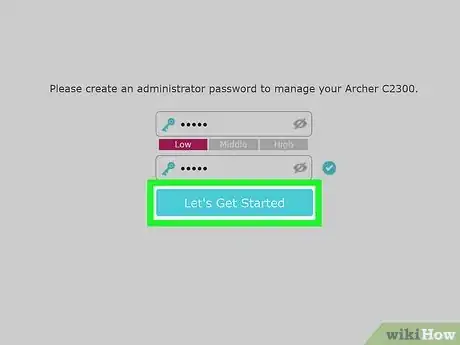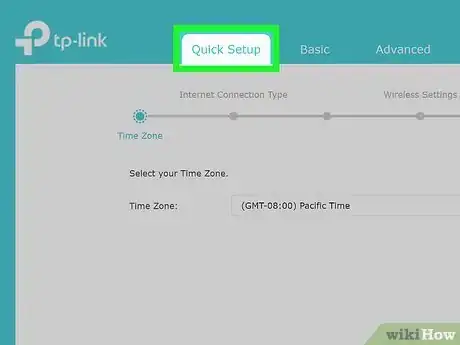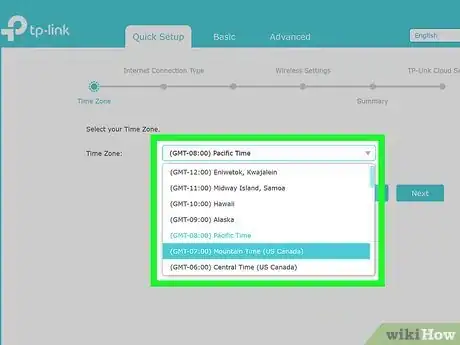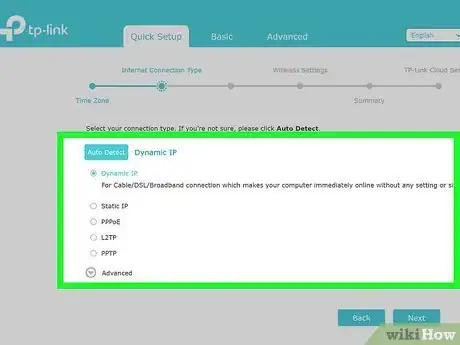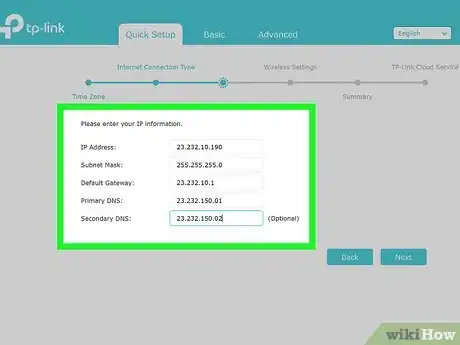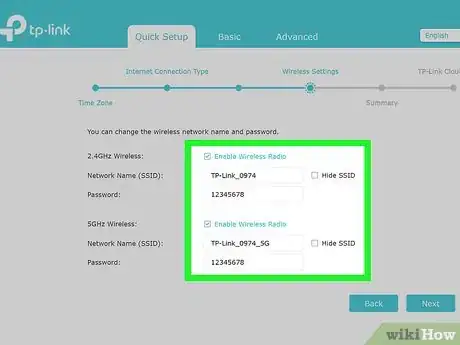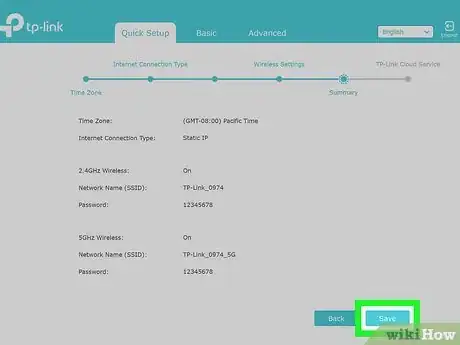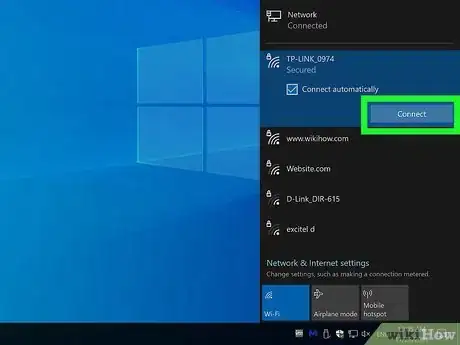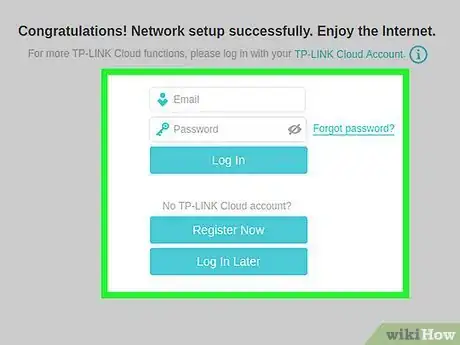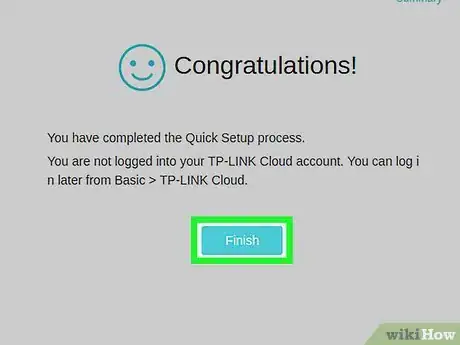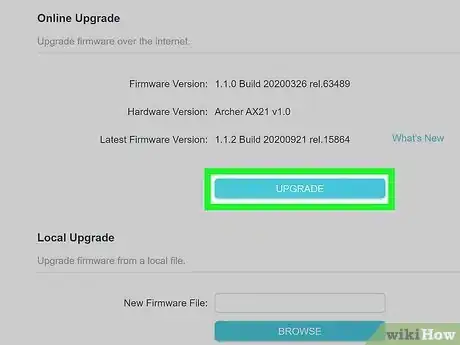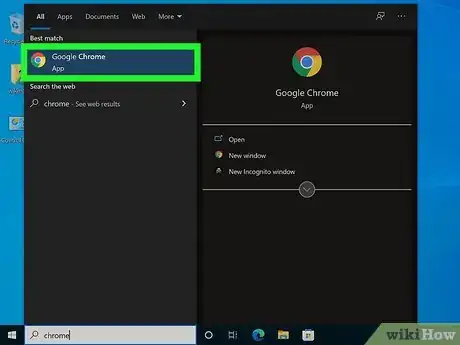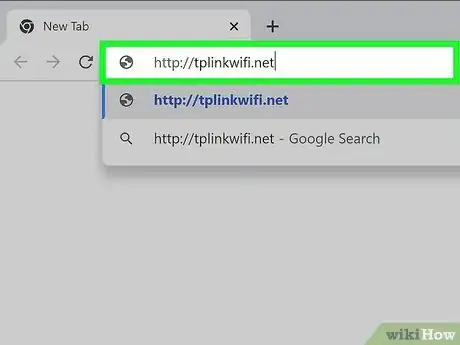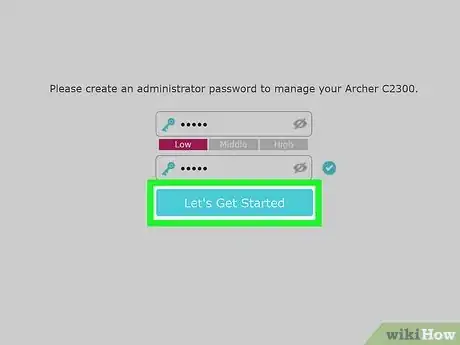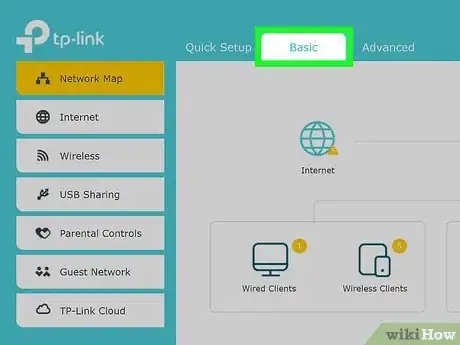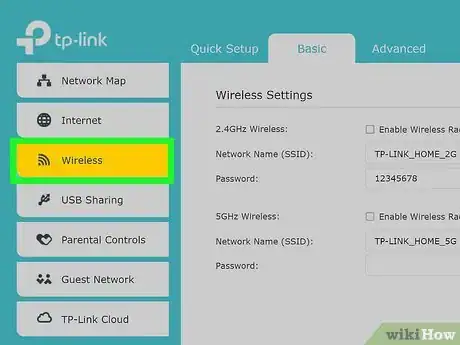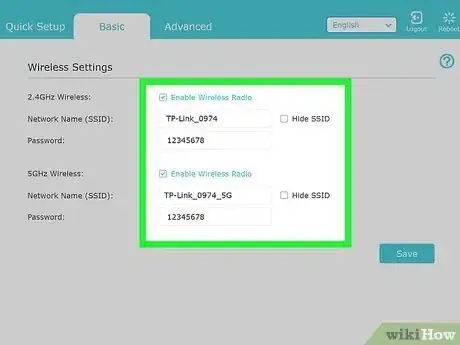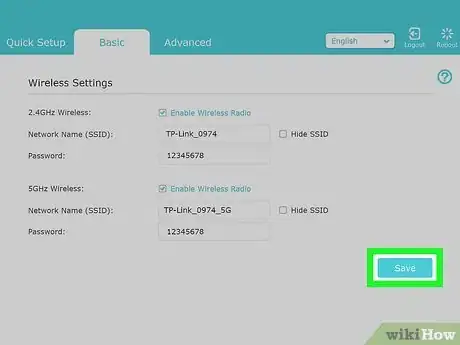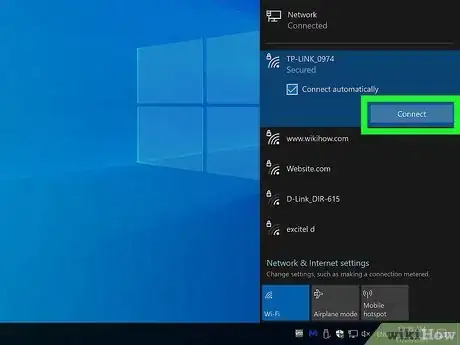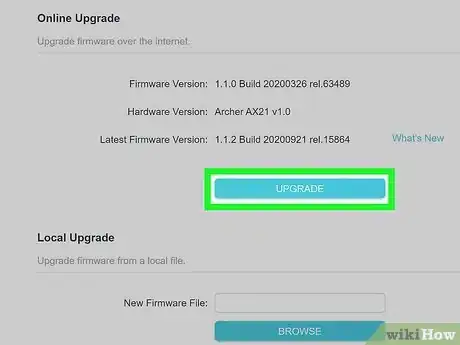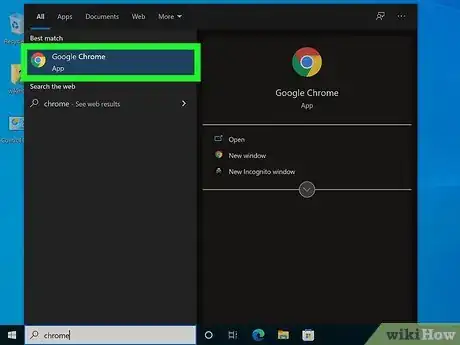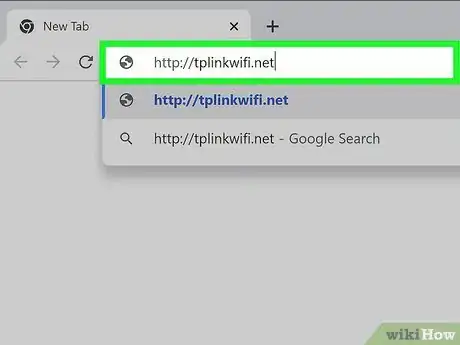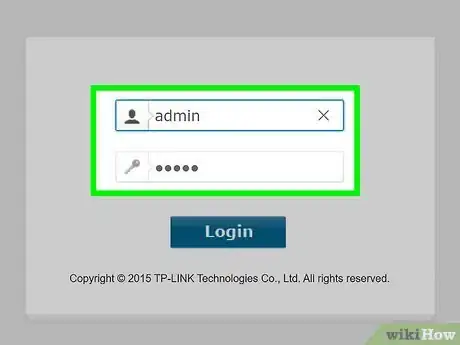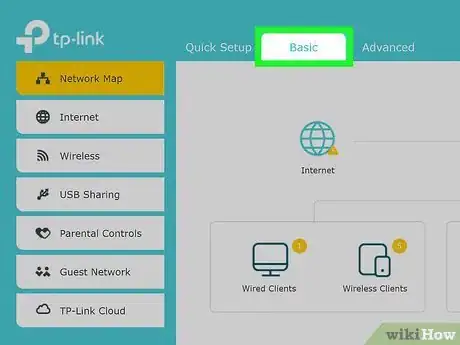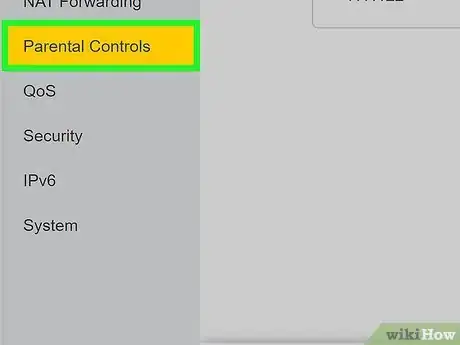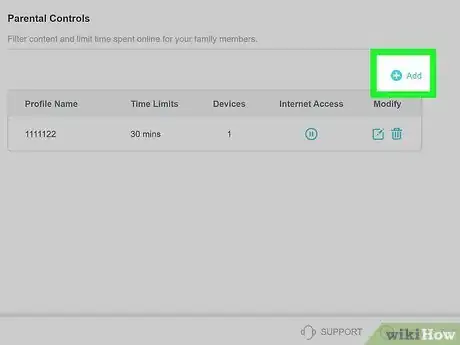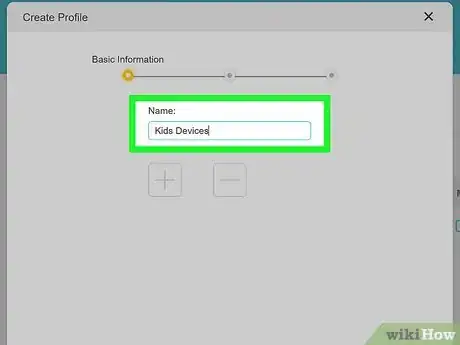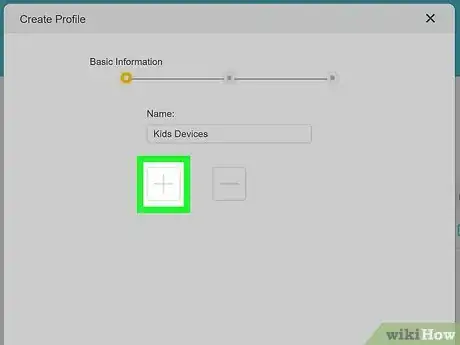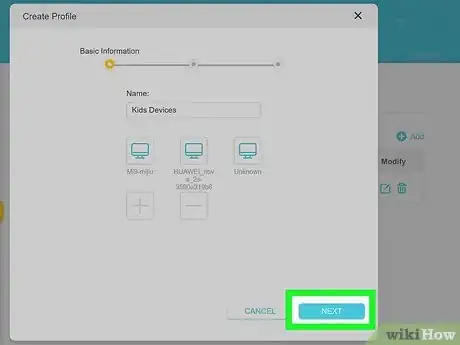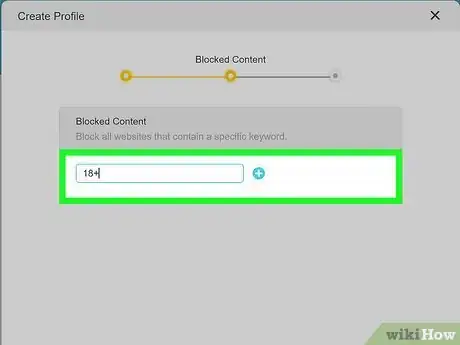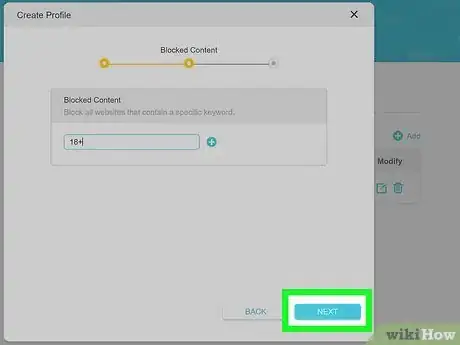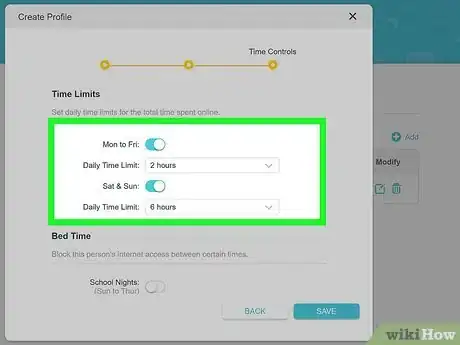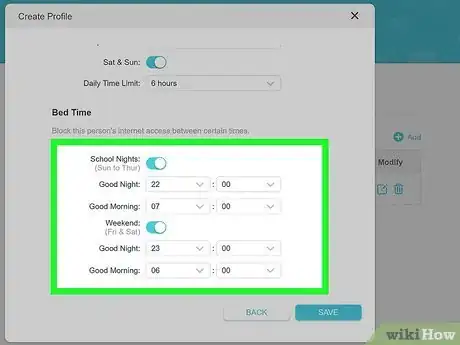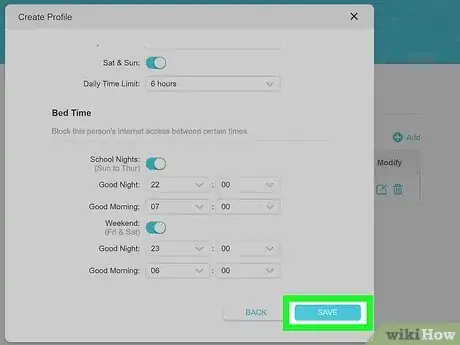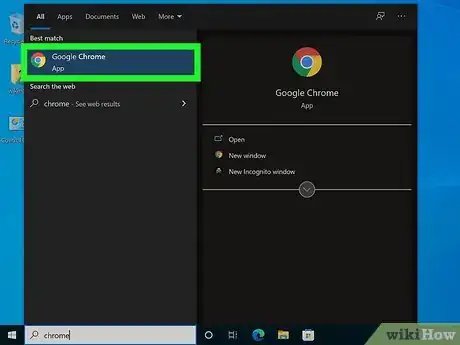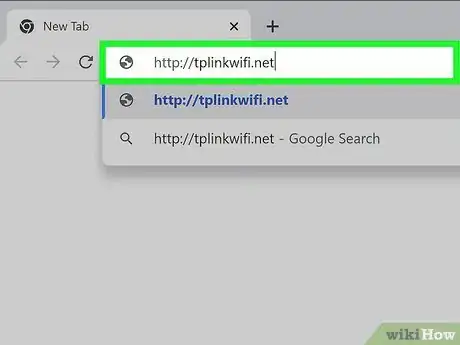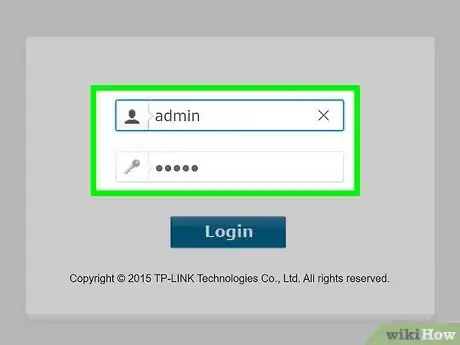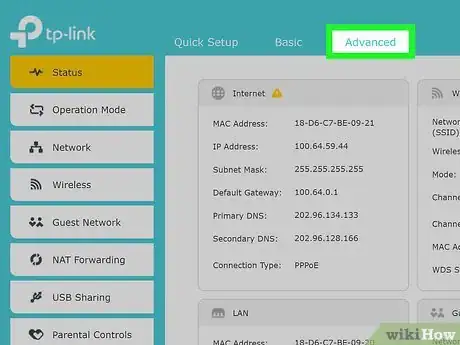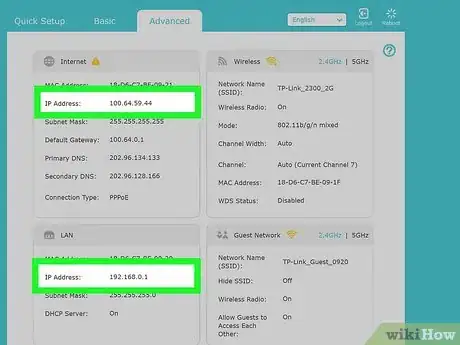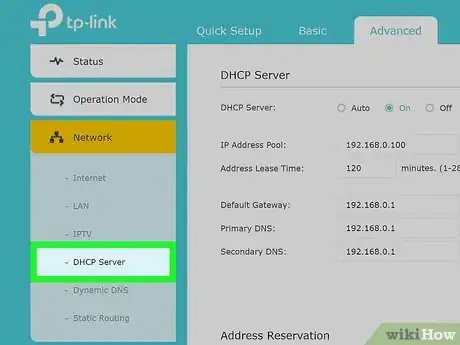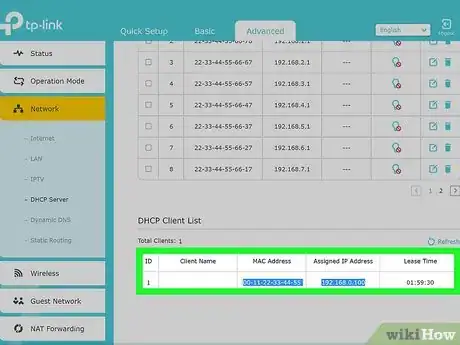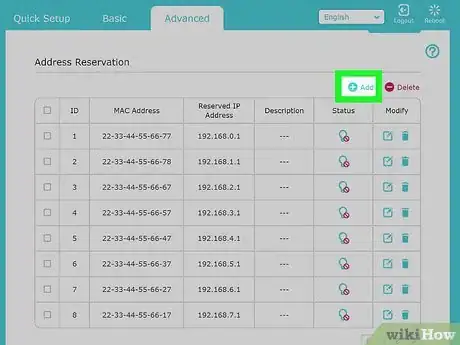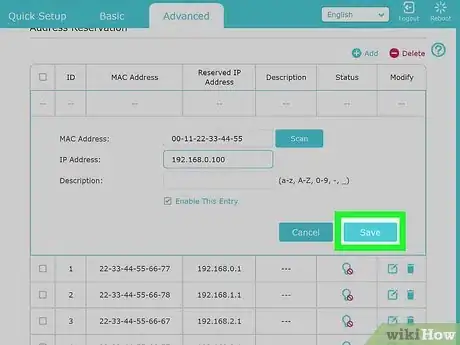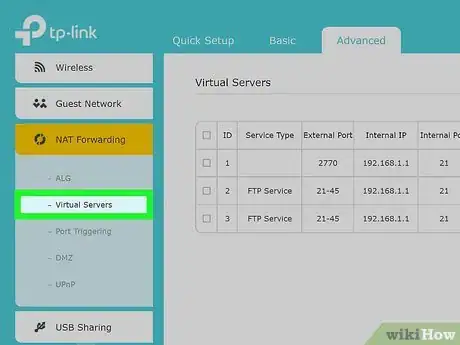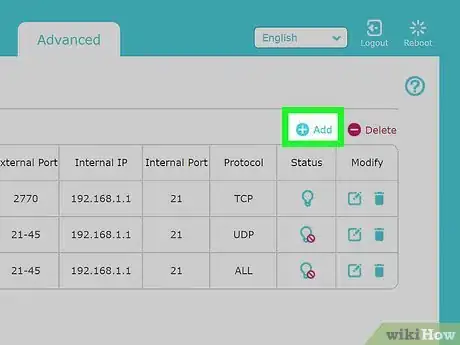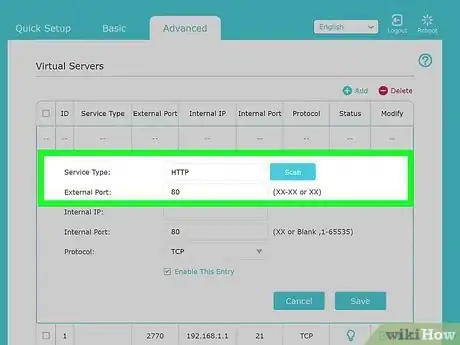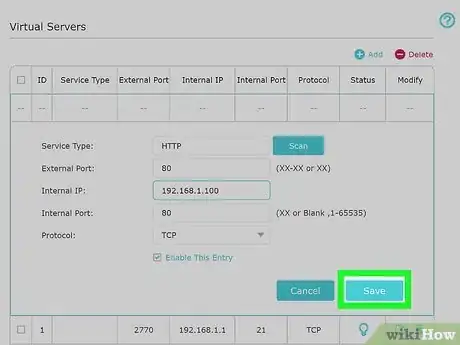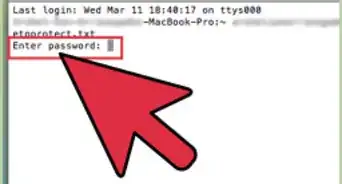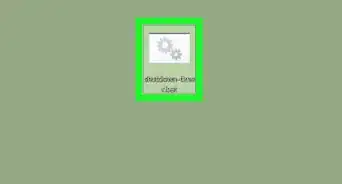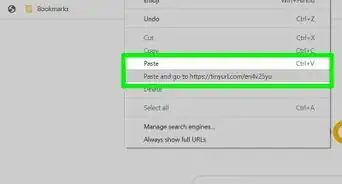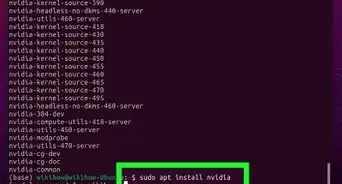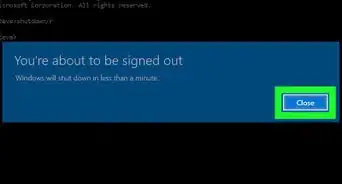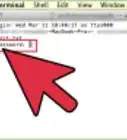This article was co-authored by wikiHow staff writer, Travis Boylls. Travis Boylls is a Technology Writer and Editor for wikiHow. Travis has experience writing technology-related articles, providing software customer service, and in graphic design. He specializes in Windows, macOS, Android, iOS, and Linux platforms. He studied graphic design at Pikes Peak Community College.
This article has been viewed 29,682 times.
Learn more...
A router is a device that connects multiple devices, such as computers and smartphones to a network. If you recently bought a new TP-Link router, you can easily configure it using the Quick Setup process using the user interface, which you can access using a web browser on your PC. If you don't have all the information you need, you can try and get your wireless network up and running using a basic setup. You can also use the web-based interface to set up parental controls on your router as well as assign port forwarding to a specific device. This wikiHow article teaches you how to configure a TP-Link router.
Steps
Setting Up The Router
-
1Power off the modem. If you have a separate modem, be sure to unplug the modem to power it off. If the modem has a battery backup, be sure to remove that too.
-
2Connect the router to the internet. You will need an ethernet cable to do so. Use one of the following steps to connect the router to the internet.
- If the router has a built-in modem, simply connect the internet cable from your internet service provider to the "WAN" or "Internet" port on the back of the router.
- If you have a separate modem, connect the internet cable in your home to the "WAN" or "Internet" port on your modem. Then connect an ethernet cable to an available "LAN" port on the back of the modem. Then connect the other end of the ethernet cable to the "WAN" or "Internet" port on the back of the router.
Advertisement -
3Plug in the modem. If you have a separate modem, go ahead and plug it back in and reinsert the battery pack to power the modem back on.
-
4Plug in the router. Make sure you use the AC adapter that came with the router. Connect the AC adapter to the power input, which is typically located on the rear of the router. Then plug the AC adapter into an electrical outlet. The router should power on. Wait for the lights on the front of the router to turn solid to indicate that the router is finished booting up.
-
5Connect a PC to the router. You'll need another ethernet cable to do so. Connect an ethernet cable to any available "LAN" port on the router. Then connect the other end to an available ethernet port on your computer.
- If your computer does not have an available ethernet port, you can purchase a USB-to-ethernet adapter and use that to connect the ethernet cable to your computer using any available USB port.
- Alternatively, you can connect to your router wirelessly using the default SSID and password that is listed on the bottom of the router or in the user's manual.
Configuring the Router Using Quick Setup
-
1Open a web browser. You can use any web browser on your computer, including Google Chrome, Safari, Firefox, or Microsoft Edge.
-
2Enter the default access address in the address bar at the top of your web browser. This opens the router's user interface. You can usually find the default access address listed on the bottom of the router or in the user's manual. The default access address is typically one of the following:[1]
-
3Create a new admin password and click Let's Get Started. This is not the Wi-Fi password, this is the password you will use to log in to the router and change the settings if the need should arise. A good, strong password should be at least 8 characters long and contain a mix of letters, numbers, and special characters. Be sure to create a password that you can remember. Enter the password twice and then click Let's Get Started to proceed.
-
4Make sure the Quick Setup tab is selected. This option walks you through the process of setting up your router. Click the Quick Setup tab at the top, if it is not already selected.
- If you are using an older TP-Link model, click Quick Setup at the top of the menu panel to the left.
-
5Select your time zone. Use the drop-down menu next to "Time Zone" to select your current time zone. Then click Next to continue.
-
6Select your internet connection type. Click the radio option next to your internet connection type. You can select "Dynamic IP," "Static IP," "PPPoE," "L2TP," "PPTP." If you are not sure what your connection type is, click Auto Detect at the top of the screen. Click Next when you are ready to continue.
- The "Auto Detect" feature may not work perfectly. Check with your internet service provider if you are not sure what type of internet connection you are using.
- If you are not able to get the information you need from your internet service provider, you can try and get your internet up and running using a basic setup.
-
7Enter your IP address and/or MAC information. Depending on what type of internet connection type you selected, you may need to enter your IP address, Subnet mask (which is usually "255.255.255.0"), your default gateway, and your primary and secondary DNS. If you are not sure what this information is, check with your internet service provider. Enter the information and click Next.
- If you are asked if you want to clone your computer's MAC address, check with your internet service provider to see if your internet access is limited to a specific MAC address. If so, make sure you are using the computer that has that MAC address and click the radio option to clone your computer's MAC address. If you are not sure, click the radio option next to "Do NOT Clone my Computer's MAC Address and click Next.
-
8Enter a network name (SSID) and password. The network name is the name people will search for when they try to connect to your wireless network. The password is what they will need to enter in order to connect to your network. Enter the network name next to "Network Name (SSID)" and enter the password next to "Password." Then click Next to continue.
- If you plan on allowing guests to connect to your network, be sure to use a password that is not used for any other apps or services. Use a password that you don't mind other people knowing.
- If you have a dual-band router, you will need to come up with a separate network name (SSID) for both the 2.4 GHz band and the 5 GHz band. The 2.4 GHz band has slower internet, but a larger range. The 5 GHz band has faster internet, but a shorter range. You can use the same password for both, but the network name needs to be unique for both.
- If you don't want your network name to appear on people's devices when they search for a wireless network, click the checkbox next to "Hide SSID." You will need to enter the network name and password manually when connecting to the wireless network.
- If your router supports Smart Connect, you can click the checkbox to enable Smart Connect. This allows devices to automatically switch from the 2.4 GHz band and the 5 GHz band automatically depending on how far away they are from the router.[2]
-
9Review the information and click Save. The summary page displays all the information you have entered so far. Review the page and make sure the information is correct. Click Save when you are ready to continue.
-
10Connect your devices to the wireless network and click Next. The next page displays your network names and passwords. Use this time to connect your wireless devices to the network. Click Next when you are ready to continue.
-
11Log in with your TP-Link ID. If you have a TP-Link ID, enter the email and password associated with your TP-Link ID and click Log In to connect to cloud services and register your router. If you do not have a TP-Link ID, you can click Register Now, enter an email address, create a password, and agree to the terms and conditions to create a TP-Link ID. You can also click Log In Later to skip this step.
-
12Click Finish. Congratulations! You have just set up your TP-Link router.[3]
-
13Update your router's firmware. Once you finish setting up your router, it's a good idea to update your router's firmware. It may take a few minutes for the router to update. Once the update is finished, the router will reboot automatically. Use the following steps to update the router's firmware:
- Enter the default access address in a web browser.
- Log in using the admin password.
- Click Update in the upper-right corner.
- Click Upgrade below "Online Upgrade" if an update is available.
- Click Yes to confirm.
- Wait for the update to finish.
Configuring the Router Using Basic Setup
-
1Open a web browser. You can use any web browser on your computer, including Google Chrome, Safari, Firefox, or Microsoft Edge.
-
2Enter the default access address in the address bar at the top of your web browser. This opens the router's user interface. You can usually find the default access address listed on the bottom of the router or in the user's manual. The default access address is typically one of the following:
-
3Create a new admin password and click Let's Get Started. This is not the Wi-Fi password, this is the password you will use to log in to the router and change the settings if the need should arise. A good, strong password should be at least 8 characters long and contain a mix of letters, numbers, and special characters. Be sure to create a password that you can remember. Enter the password twice and then click Let's Get Started to proceed.
-
4Click Basic. It's the second tab at the top of the screen. This allows you to configure your router using basic steps and with minimal information needed.
-
5Click Wireless. It's the third option in the menu panel on the left. This allows you to configure your wireless settings.
-
6Click the checkbox to enable the network bands. Most dual-band wireless routers have two networks you can enable and connect to. The 2.4 GHz band has slower internet but a larger range. The 5 GHz band has faster internet, but a shorter range. Click the checkbox next to the networks you want to enable. You can enable both networks at the same time.
-
7Enter the network name (SSID) and password for the networks. The network name is the name people will search for when they try to connect to your wireless network. The password is what they will need to enter in order to connect to your network. You will need to enter a unique network name for both the 2.4 GHz network and the 5 GHz network. However, you can use the same password for both of them.
- If you plan on allowing guests to connect to your network, be sure to use a password that is not used for any other apps or services. Use a password that you don't mind other people knowing.
- If you are using an older TP-LInk model, you will need to click Wireless 2.4 GHz and Wireless 5 GHz in the menu to the left to configure both network bands.
- If you don't want your network name to appear on people's devices when they search for a wireless network, click the checkbox next to "Hide SSID." You will need to enter the network name and password manually when connecting to the wireless network.
-
8Click Save. It's the blue button in the lower-right corner. This saves your network settings.
-
9Reconnect to the internet. When you change the name and password of your wireless network, your computer and devices will be automatically logged out. Log back into the network using the network name (SSID) and password you set in the router settings. You should now be able to connect to the internet.
-
10Update your router's firmware. Once you finish setting up your router, it's a good idea to update your router's firmware. It may take a few minutes for the router to update. Once the update is finished, the router will reboot automatically. Use the following steps to update the router's firmware:
- Enter the default access address in a web browser.
- Log in using the admin password.
- Click Update in the upper-right corner.
- Click Upgrade below "Online Upgrade" if an update is available.
- Click Yes to confirm.
- Wait for the update to finish.
Setting Up Parental Controls
-
1Open a web browser. You can use any web browser on your computer, including Google Chrome, Safari, Firefox, or Microsoft Edge. You can use the web-based interface to configure parental controls for your TP-Link router. You can use parental controls to block websites or keywords on specific devices as well as set time limits on specific devices.
-
2Enter the default access address in the address bar at the top of your web browser. This opens the router's user interface. You can usually find the default access address listed on the bottom of the router or in the user's manual. The default access address is typically one of the following:
-
3Log in with the administrative password and click Log In. This is the password you set when you first opened the user interface during the initial router setup. Enter the administrative password and click Log In.
- If you have not yet set an administrative password, enter a new password and click Let's Get Started. Then click Quick Setup and complete the initial setup process.
-
4Click the Basic tab. It's the second tab at the top of the page. This allows you to configure your router using basic steps and with minimal information needed.
-
5Click Parental Controls. It's the fifth option in the menu on the left side. It has an icon that resembles a large person and a small child.
-
6
-
7Type a name for the profile. Enter the name for the parental control profile next to "Name."
-
8Select a device to apply the parental controls to. Use the following steps to do so:
- Click the large plus (+) icon below "Devices."
- Click the checkbox next to the device(s) you want to apply the settings to.
- Click Save in the lower-right corner.
-
9Click Next. If the devices listed below "Devices" are correct, click Next in the lower-right corner to continue.
-
10Enter a keyword for the content you want to block and click Add. You can enter a keyword to block content from any website that contains that keyword, or you can enter the name of a specific website or app.
- You can add as many keywords or websites you want to block.
-
11Click Next. When you have entered all the keywords you want to block, click Next to continue.
-
12Set a daily time limit. To do so, click the checkbox next to Enable below "Time Limits." Then use the slider bar to set a daily time limit for how long the device can be online each day. You can set a separate daily time limit for weekdays (Mon to Fri) and weekends (Sat & Sun).
-
13Set a bedtime limit. This blocks internet access on the device during bedtime hours. To set a bedtime limit, click the checkbox next to Enable below "Bedtime." Then use the boxes next to "From:" and "To:" to set a time period in which the device is blocked from accessing the internet (i.e. "From: 9:00 PM, To: 6:00 AM"). You can set a separate bedtime for weekdays and weekends.
-
14Click Save. This saves the profile. You can add more profiles to create different restrictions.[4]
Configuring Port Forwarding
-
1Open a web browser. You can use any web browser on your computer, including Google Chrome, Safari, Firefox, or Microsoft Edge. If a computer or device requires access to a specific port or external web address, you can set up port forwarding on your router to allow the device to directly connect to the external internet. You can set up port forwarding in the web-based interface.
-
2Enter the default access address in the address bar at the top of your web browser. This opens the router's user interface. You can usually find the default access address listed on the bottom of the router or in the user's manual. The default access address is typically one of the following:
-
3Log in with the administrative password and click Log In. This is the password you set when you first opened the user interface during the initial router setup. Enter the administrative password and click Log In.
- If you have not yet set an administrative password, enter a new password and click Let's Get Started. Then click Quick Setup and complete the initial setup process.
-
4Click Advanced. It's the third tab at the top of the screen. This is where you can make advanced configurations on your TP-Link router.
-
5Note the public and private IP addresses. Your public IP address is listed next to "IP Address" in the box labeled "Internet." Your private IP address is listed next to IP Address" in the box labeled "WAN." Write down both numbers.
-
6Open the "DHCP Server" page. To do so, click Network in the menu panel to the left to expand the Network menu. Then click DHCP Server in the menu below "Network".
-
7Note the IP address and MAC address for the device you want to port forward. To do so, scroll down to the "DHCP Client List" table. This lists all devices connected to your network. Identify the device you want to apply port forwarding to by the device name. Then write down the assigned IP address and MAC address.
-
8
-
9Enter the MAC address and IP address and click Save. Enter or copy and paste the MAC address next to MAC Address. Then enter the IP address next to IP Address. Enter a description, if you want. Then click Save. This ensures the router will always assign that IP address to that device.
-
10Open the Virtual Servers page. To do so, scroll down and click NAT Forwarding in the menu panel to the left. Then click Virtual Servers.
-
11
-
12Select the service type. Services include HTTP, FTP, DNS, Gopher, NNTP, etc. To select a service type click View Existing Services next to "Service Type". Then click Choose next to the service type you want to select. The port number for that service type will be auto-filled.
- If the service you are connecting to uses a different port number than what is auto-filled, you will need to check with that service to find out the correct port number.
-
13Enter the device's IP address and click Save. Enter the same IP address you previously assigned the device next to "Internal IP address." Click Save in the lower-right corner when you are finished. This assigns port forwarding to the device.
- To visit the server you just added in a web browser on your network or outside your network by entering the public IP address in the address bar, followed by a colon (:) followed by the port number (i.e 119.139.172.01:80).[5]
References
About This Article
1. Connect the router to the internet and plug it in.
2. Connect a PC to the router using the default SSID or a wired connection.
3. Go to http://tplinkwifi.net/ in a web browser.
4. Set a new admin password and click Let's Get Started.
5. Select your time zone and click Next.
6. Select your internet connection type and click Next.
7. Enter your IP and/or MAC information and click Next.
8. Enter a network name (SSID) and password for your networks.
9. Review you information and click Save.
10. Connect your devices to your network.
11. Log in with your TP-Link ID.
12. Click Update in the upper-right corner and update your firmware.
